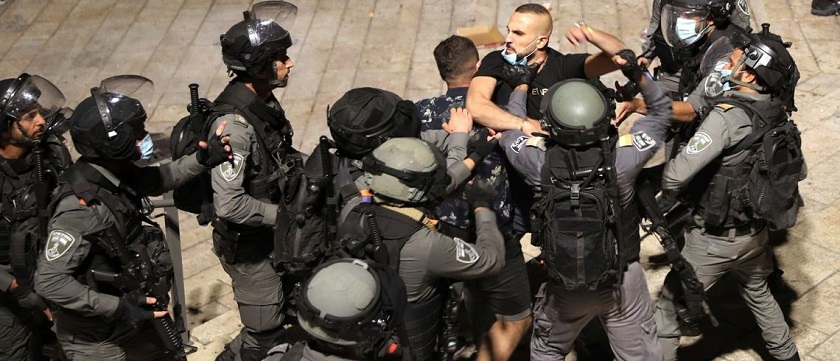
Israel has one of the world’s most modernised armies equipped with a nuclear arsenal. On the other hand, Palestinians, having no real state and regular army, don’t have much to defend themselves.
When Israel’s controversial court-ordered expulsions of Palestinian homeowners in occupied East Jerusalem led to protests and a violent reaction from Israeli authorities, the ensuing escalation led pundits to ask whether a full-scale war was on the horizon.
But even if it evolves into a fully-fledged war, it will be a deeply unfair one, if you consider the military, political and economic capabilities of each side.
Let’s break down what both sides have in their disposal to fight each other:
Armed forces
The Israeli Defence Forces (IDF) has nearly 170,000 active military personnel while it lists more than three million males and females available for army service. It’s an extraordinary number for an overall population of just 9 million, showing just how heavily militarised Israel has become.
The IDF also boasts a huge budget, with $20.5 billion available according to 2019 estimates and ranked 15th in terms of military expenditure globally.
On the other hand, without any real state or regular army, different Palestinian resistance groups have much less manpower than the Israeli army, amounting to circa 30,000 to 50,000 in troops.
According to different estimates, Hamas has between 10,000-20,000 fighters. In 2009, the International Crisis Group estimated the strength of the Qassam Brigades, Hamas’ armed wing, as between 7,000 and 10,000. But most recent estimates say the group’s manpower could be as high as nearly 40,000. Islamic Jihad, another armed group backed by Iran, has fighters in the region of between 8,000–9,000.
The Palestinian Authority’s security forces, which were created under the failed Oslo Peace Accords, signed by the Palestinian Liberation Organisation (PLO) and Israel, are mostly funded by the US and the EU, and act in coordination with Tel Aviv. Most of the PLO fighters are integrated into this force, numbering around 83,000.
Many Palestinians and commentators see the Oslo Accords as a discredited agreement, which has turned the PLO’s fighting capacity into a submissive security force under de facto Israeli control. As a result, in an active war between Palestinians and Israelis, the Palestinian Authority’s security forces cannot play any military role.
Weapons
The Israeli army has various weapons produced by the country’s homegrown military industry, which is one of the biggest exporters in the world, selling arms to countries like Russia and the US. Many European countries are also clients.
Israel has also secretly developed nuclear weapons, which have not been produced under the Non-Proliferation Treaty (NPT), an international agreement regulating the rules of the world’s nuclear inventory.
While groups like Hamas, with the help of other countries, want to build their own rockets and other military equipment in Gaza, Palestinians have no national defence industry.
According to estimates, the Israeli Air Force has at least 684 fighter jets, while the Palestinians have no aircraft. Despite Palestinians having no air force, some American media outlets recently published reports saying that “Airstrikes from Hamas militants kill 20 in Israel”. The Israeli Air Force has 34,000 active personnel.
With its 10,000 active duty personnel, the Israeli Navy has 4 corvettes, 8 missile boats, 5 submarines, 45 patrol boats and 2 support ships. The Palestinians have little more than a few fishing boats in Gaza.
Despite huge discrepancies between the two sides’ military capabilities, Israelis constantly complain about the number of Hamas and Islamic Jihad rockets.
“Israeli intelligence assesses that most of Hamas’s arsenal of 5,000 to 6,000 rockets can strike somewhere between the Gaza border communities and 40-55 km. away,” said a Jerusalem Post report. The Israeli newspaper also said that Islamic Jihad possesses 8,000 short-range rockets.
According to Israeli intelligence, Hamas has dozens of rockets with a range of 100-160km, while Islamic Jihad has a very small number of Buraq-100 rockets with a range of more than 100km. Hamas might also have hundreds of rockets with a range of 70-80km that could have the ability to reach cities like Tel Aviv. Most rockets are made by Iran.
On the other hand, Israel has sophisticated and diverse systems of both ballistic and cruise missiles. They could hit not only Palestinian cities but also countries like Egypt, Syria and Iran.
“Most estimates of Israel’s missile capabilities indicate that Israel possesses nuclear-capable medium-range ballistic missiles (MRBM); short-range sub-sonic cruise missiles with advanced capabilities such as non-line of sight targeting (NLOS) and midflight maneuverability; and significant defensive missile capabilities,” said a report conducted by NTI, a nuclear watchdog.
“The Jericho-2 boasts an estimated 1,500km range with a 1,000km payload, a range which would encompass all of Egypt, Syria, and Iraq, but only the border regions of western Iran; some observers, however, have assessed the missile to possess a 3,500km range, which would reach all of Iran,” the same report added.
While Israel continues to keep its missile inventory secret, analysts think that the country has an incomparable superiority over the rockets of Hamas and Islamic Jihad.
Lastly, Israel has an effective Iron Dome air-defence system to protect itself against Hamas and Islamic Jihad rockets. (Source: TRT World)
Follow this link to join our WhatsApp group: Join Now
Be Part of Quality Journalism |
Quality journalism takes a lot of time, money and hard work to produce and despite all the hardships we still do it. Our reporters and editors are working overtime in Kashmir and beyond to cover what you care about, break big stories, and expose injustices that can change lives. Today more people are reading Kashmir Observer than ever, but only a handful are paying while advertising revenues are falling fast. |
| ACT NOW |
| MONTHLY | Rs 100 | |
| YEARLY | Rs 1000 | |
| LIFETIME | Rs 10000 | |










